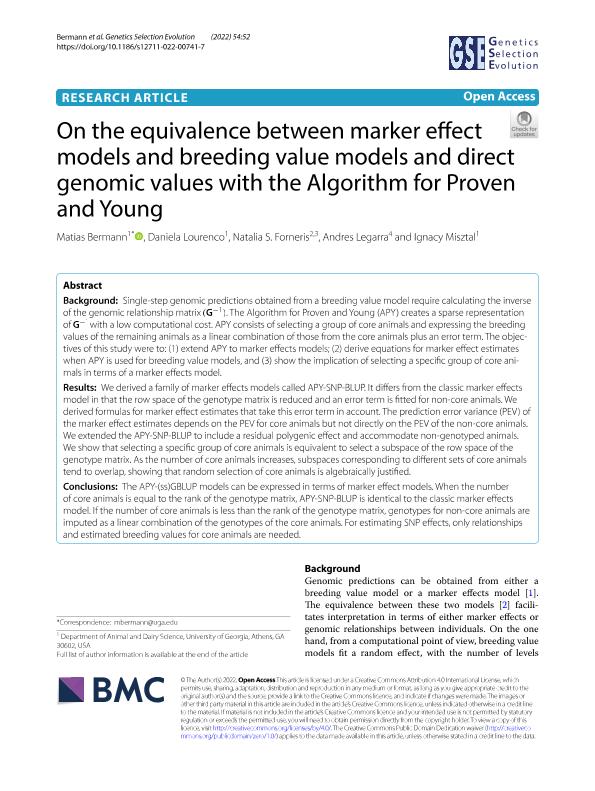Mostrar el registro sencillo del ítem
dc.contributor.author
Bermann, Matias
dc.contributor.author
Lourenco, Daniela
dc.contributor.author
Forneris, Natalia Soledad

dc.contributor.author
Legarra, Andres

dc.contributor.author
Misztal, Ignacy

dc.date.available
2023-08-18T14:12:36Z
dc.date.issued
2022-07-16
dc.identifier.citation
Bermann, Matias; Lourenco, Daniela; Forneris, Natalia Soledad; Legarra, Andres; Misztal, Ignacy; On the equivalence between marker effect models and breeding value models and direct genomic values with the Algorithm for Proven and Young; BioMed Central; Genetics Selection Evolution; 54; 1; 16-7-2022; 1-10
dc.identifier.issn
0999-193X
dc.identifier.uri
http://hdl.handle.net/11336/208704
dc.description.abstract
Background: Single-step genomic predictions obtained from a breeding value model require calculating the inverse of the genomic relationship matrix (G- 1). The Algorithm for Proven and Young (APY) creates a sparse representation of G- 1 with a low computational cost. APY consists of selecting a group of core animals and expressing the breeding values of the remaining animals as a linear combination of those from the core animals plus an error term. The objectives of this study were to: (1) extend APY to marker effects models; (2) derive equations for marker effect estimates when APY is used for breeding value models, and (3) show the implication of selecting a specific group of core animals in terms of a marker effects model. Results: We derived a family of marker effects models called APY-SNP-BLUP. It differs from the classic marker effects model in that the row space of the genotype matrix is reduced and an error term is fitted for non-core animals. We derived formulas for marker effect estimates that take this error term in account. The prediction error variance (PEV) of the marker effect estimates depends on the PEV for core animals but not directly on the PEV of the non-core animals. We extended the APY-SNP-BLUP to include a residual polygenic effect and accommodate non-genotyped animals. We show that selecting a specific group of core animals is equivalent to select a subspace of the row space of the genotype matrix. As the number of core animals increases, subspaces corresponding to different sets of core animals tend to overlap, showing that random selection of core animals is algebraically justified. Conclusions: The APY-(ss)GBLUP models can be expressed in terms of marker effect models. When the number of core animals is equal to the rank of the genotype matrix, APY-SNP-BLUP is identical to the classic marker effects model. If the number of core animals is less than the rank of the genotype matrix, genotypes for non-core animals are imputed as a linear combination of the genotypes of the core animals. For estimating SNP effects, only relationships and estimated breeding values for core animals are needed.
dc.format
application/pdf
dc.language.iso
eng
dc.publisher
BioMed Central

dc.rights
info:eu-repo/semantics/openAccess
dc.rights.uri
https://creativecommons.org/licenses/by/2.5/ar/
dc.subject
seleccion genomica
dc.subject
relaciones genomicas
dc.subject
valor de cria
dc.subject
exactitud
dc.subject.classification
Producción Animal y Lechería

dc.subject.classification
Producción Animal y Lechería

dc.subject.classification
CIENCIAS AGRÍCOLAS

dc.title
On the equivalence between marker effect models and breeding value models and direct genomic values with the Algorithm for Proven and Young
dc.type
info:eu-repo/semantics/article
dc.type
info:ar-repo/semantics/artículo
dc.type
info:eu-repo/semantics/publishedVersion
dc.date.updated
2023-07-08T00:24:47Z
dc.identifier.eissn
1297-9686
dc.journal.volume
54
dc.journal.number
1
dc.journal.pagination
1-10
dc.journal.pais
Reino Unido

dc.journal.ciudad
Londres
dc.description.fil
Fil: Bermann, Matias. University of Georgia; Estados Unidos
dc.description.fil
Fil: Lourenco, Daniela. University of Georgia; Estados Unidos
dc.description.fil
Fil: Forneris, Natalia Soledad. Consejo Nacional de Investigaciones Científicas y Técnicas. Oficina de Coordinación Administrativa Parque Centenario. Unidad Ejecutora de Investigaciones en Producción Animal. Universidad de Buenos Aires. Facultad de Ciencias Veterinarias. Unidad Ejecutora de Investigaciones en Producción Animal; Argentina
dc.description.fil
Fil: Legarra, Andres. Institut National de la Recherche Agronomique; Francia
dc.description.fil
Fil: Misztal, Ignacy. University of Georgia; Estados Unidos
dc.journal.title
Genetics Selection Evolution

dc.relation.alternativeid
info:eu-repo/semantics/altIdentifier/doi/http://dx.doi.org/10.1186/s12711-022-00741-7
dc.relation.alternativeid
info:eu-repo/semantics/altIdentifier/url/https://gsejournal.biomedcentral.com/articles/10.1186/s12711-022-00741-7
Archivos asociados
